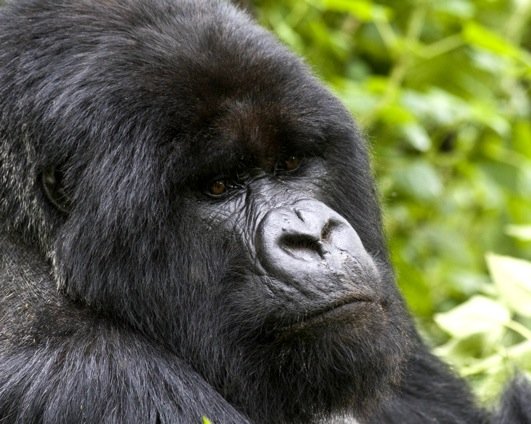
The last of the Great Apes genome has been sequenced after a British research team in Cambridge has deciphered the genetic code of the gorilla.
Researchers can now begin to examine the similarities and differences between the apes, the journal Nature reports.
Genome sequences of humans, chimpanzees and orangutans are already published.
The research team hopes their work will help to uncover genetic mutations that led to language, culture and science.
“I’d like to think that in the next 20 or 30 years we will get a deeper understanding of what happened genetically in our evolutionary history, and of how those genes affect the brain and other properties that make us modern humans,” said Richard Durbin of the Wellcome Trust Sanger Institute, who led the study.
Initial comparisons confirm that chimpanzees are our closest relatives, sharing 99% of our DNA. Gorillas come a close second with 98%, and orangutans third with a 97% share.
That reflects the evolutionary history of apes. Genome comparison indicates that the human lineage separated from orangutans 14 million years ago, gorillas 10 million years ago, and chimps 6 million years ago.
That order of events is not a surprise, but the dates are earlier than many scientists had thought.
Although on average humans are closest to chimps, many of our individual genes are more like those of gorillas.
Among them is a gene that enables us and gorillas to hear better than other apes.
Until now, some scientists had thought that the development of hearing was what enabled us to develop language – but as a result of this research, we now know this theory is wrong.
Fifteen percent of the human genome is closer to the gorilla than the chimpanzee, and 15% of the chimpanzee genome is closer to the gorilla than to humans.
One genetic difference that will be of interest to medical researchers is a mutation that results in dementia in humans, but seems to leave gorillas completely unaffected.

The genome unraveled in the research came from a female western lowland gorilla (Gorilla gorilla gorilla) called Kamilah.
Researchers searched through more than 11,000 genes in her genome, as well as in the published versions of the human, chimp and orangutan genetic codes, for changes important in evolution.
“Our most significant findings reveal not only differences between the species, reflecting millions of years of evolutionary divergence, but also similarities in parallel changes over time since their common ancestor,” said Chris Tyler-Smith, who works with Dr. Richard Durbin.
Comparative studies will also shed more light on the evolution of all the Great Apes; but the key question is whether the bounty of genetic information contains clues to the moment when the first genes emerged that made humans capable of abstract thought.
“This is the question we are all fascinated by,” said Dr. Richard Durbin.
It is unlikely that a single development led to our species’ advance towards modernity, or that all developments along that path were genetic.
Anatomically modern humans (Homo sapiens) emerged around 200,000 years ago, but it was not until about 50,000 years ago that our bigger brains began to make a difference.
Until then, humanity was one among small number of apes in Africa, probably living not very differently from gorillas.
So, something happened very rapidly around that time that led to the emergence of abstract thought, allowing humans to invent advanced tools and use them to shape the environment.
“There will have been genetic factors, but also cultural and historic factors,” said Dr. Richard Durbin.
The one Great Ape not to be sequenced so far is the bonobo, a close relative of the chimp. That project is underway, and scientists expect its genome and that of the chimp to be very similar.
The availability of the genomes of all the Great Apes will help scientists answer what happened over the past 200,000 years to enable our species become what we are now.